Get ready to implement the tips below, which will improve your business:
- Set SMART marketing objectives
- Track the right KPIs
- Design a simple, logical website structure
- Create a clear positioning statement
- Create a Google Business Profile
- Target low-competition topics
- Build a following on one social network
- Build a damn email list
- Target topics with search traffic potential
- “Steal” your competitors’ keywords
- Create a versus page
- Make a statistics page
- Use HARO
- Capture featured snippets
- Rank videos on Google
- Run ads on less popular platforms
- Outsource boring tasks
- Double down on what’s working
- Be different
What is the first thing you do when you begin planning for a vacation? You decide where to go, aka the destination.
It’s the same for marketing. To head somewhere, you must first decide where you want to go. You can’t know if you’ve reached your destination if you don’t set one in the first place.
That means knowing what marketing objectives you’re trying to achieve.
You can’t be vague too. “Increase sales by 30%” inspires no one. Instead, you should create objectives that fit the SMART criteria:
- Specific – Clearly state the desirable outcome and explain who, what, when, how much, etc.
- Measurable – Track progress with key performance indicators (KPIs).
- Achievable – Set bold goals, but also be realistic; use the current growth as a benchmark.
- Relevant – Does the objective align with your overall marketing and business strategy?
- Timely – Set up a time frame for achieving the goal.
For example, if we were to create a marketing objective for our blog, it might be something like this:
Grow organic traffic from 300K to 700K by the end of 2022.
Recommended reading: Marketing Objectives: How to Set Them Right (With Examples)
Your GPS tells you if you’re going the right way when traveling. But what’s the GPS for your marketing?
Those are your marketing KPIs. After you’ve decided on your objectives (i.e., your destination), these KPIs tell you if you’re going in the right direction.
But not all KPIs are equal. You likely don’t care about how many kilometers you’ve traveled. You just want to know if you’re getting closer or farther away. Same goes for marketing. There are many KPIs you can track, but most are simply vanity metrics.
You only need to track a few to know if you’re going in the right direction. Read the article below to find out which KPIs are worth your time.
Recommended reading: 7 Marketing KPIs Actually Worth Tracking
People and search engines may struggle to find pages on a disorganized website. So it’s usually best to use a flat website structure where all pages are no more than a few clicks away from the homepage.

We recommend that most of your pages should be no more than four clicks from the homepage. If there are pages more than six clicks away, consider bringing them closer to your homepage to make it easier for visitors and search engines to find them.
Recommended reading: Website Structure: How to Build Your SEO Foundation
Even in tiny Singapore, there are hundreds of gyms and fitness centers. Why should someone choose your business over the others?
They won’t—unless you tell them why.
This is called positioning. And in your positioning statement, you must clearly explain what your product or service is, why it’s different, and why it matters to your target customers.
It is impossible to teach you how to create one in a blog post (it’d take a book!), so I highly recommend that you read April Dunford’s “Obviously Awesome”—a step-by-step guide to creating a positioning statement.
Here’s a quick Cliffs Note:
- Understand who your best customers are
- List your competitive alternatives
- Figure out the attributes and features that make your product/service unique
- Figure out what these attributes and features do for your customers
- Find a target market that cares about these values
If you’re a local business serving local customers, you’ll need a Google Business Profile. Claiming this profile helps you rank better on relevant Google searches—both on web search and Google Maps.
Optimizing this is easy with Google My Business and takes only 30 minutes of your time. It’s a low-hanging fruit you should pick.
Follow the guide below to learn how to create an optimized profile.
Recommended reading: How to Optimize Google My Business in 30 Minutes
Finance writer Morgan Housel writes:
The key is recognizing that the long run is just a collection of short runs, and capturing long-term growth means managing the short run effectively enough to ensure you can stick around for a long time.
Simply put, if you can’t survive now, you can’t exist in the long term. So even if you want to rank for the most valuable keywords for your business, that’ll take time. Meanwhile, start ranking for low-competition keywords.
These are keywords you can rank for without much effort. You usually won’t have to build many links or have high website authority to rank for them and get organic traffic for your website.
How do you find these keywords? Watch this video to learn how:
Recommended reading: How to Find Low-Competition Keywords for SEO
Should you start shimmying on TikTok or go old-school and stick with Instagram? Perhaps you should create multiple 🧵 on Twitter or write broetry on LinkedIn. Or maybe you should take a punt on that new, upcoming social platform.
Whatever it is, just choose one. Don’t join a platform just because it’s the latest, shiny tool.
The allure to be present on multiple social media platforms is huge. But don’t give in to that temptation. Doing well on each platform means creating content that fits in natively. That is a lot of time, effort, and resources.
It takes work, even if you’re repurposing content. Sure, Gary Vee may make it look easy, but that’s because he has a team behind him. If you’re a one-person operation, you can’t replicate his efforts overnight.
Which social network should you choose? Well, that goes all the way back to your marketing objective (tip #1). If your target audience is on Twitter and it moves you closer to your goal, then that’s the platform you want.
After you’ve built a strong following, expand to other social media platforms. For example, Instagram has been around since 2010, but we’ve only recently started our Instagram account.
Even though we recommend building a following on one platform, you should remember that you’ll never own that audience. You’re “borrowing,” which means you’re always at the mercy of the platform.
If it wants to limit your reach one day, it can. But email is different—you own the list. Nobody can limit your reach. So even though building an email list seems like digital marketing advice from 2005, it’s not bad advice.
Every business should have an email list.
The simplest way to build one is to offer potential subscribers something in exchange for joining the list. This can be anything: an eBook, a course, a discount, or more.
For us at Ahrefs, we have a simple “subscribe” opt-in:

If you want to rank on Google, the topic you’re targeting should be one that people are searching for. That makes sense, right? Yet, most businesses begin blogging by creating an article and praying that it ranks.
Hope is not a strategy. We want to get intentional. We want our articles to rank. To do that, we need to target topics with search traffic potential.
How do you find such topics? Here’s how:
- Go to Ahrefs’ Keywords Explorer
- Enter a relevant topic
- Go to the Matching terms report
- Switch the tab to Questions
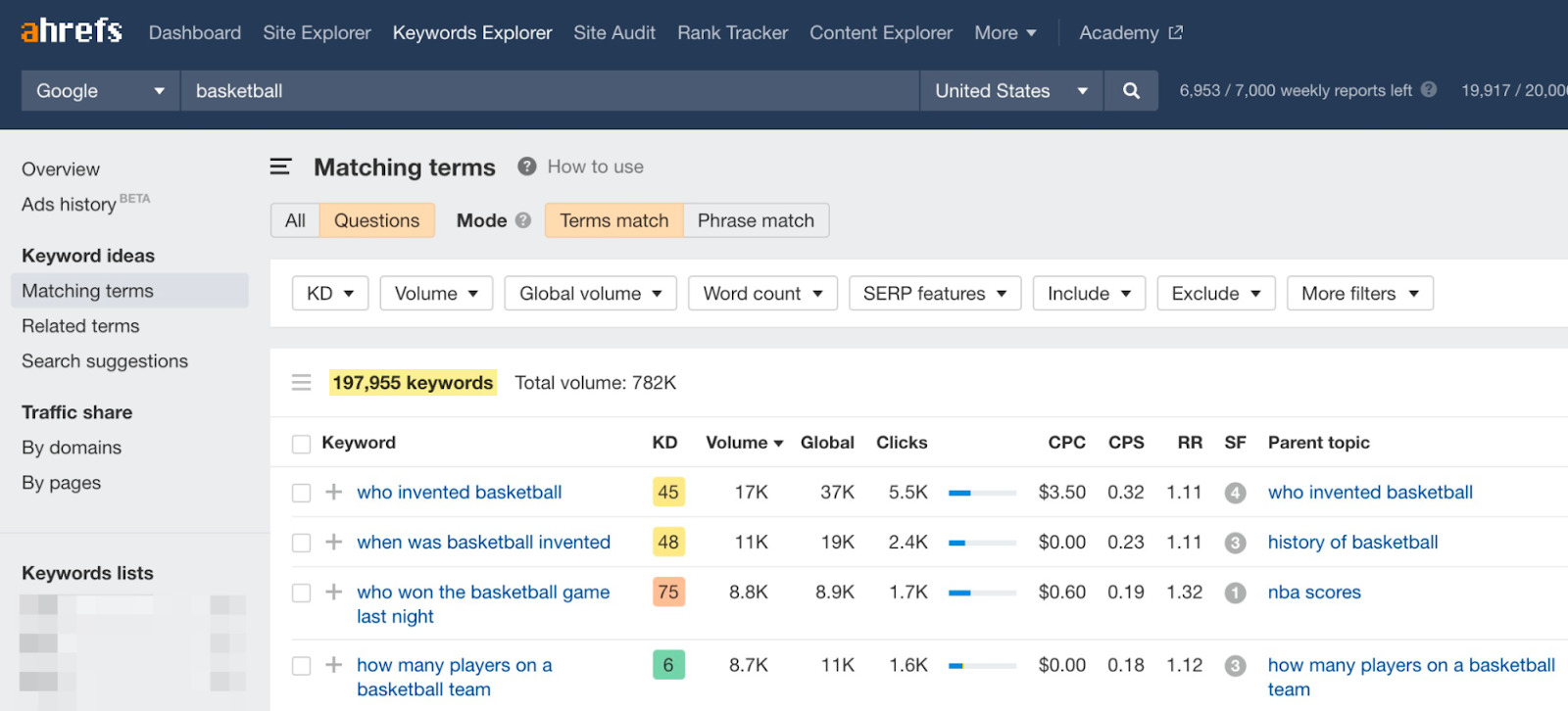
As you can see, there are over 197K topics you could potentially target. Eyeball the list and pick out topics that are relevant.
Recommended reading: Keyword Research: The Beginner’s Guide by Ahrefs
What if you could figure out which keywords your competitors rank for so that you could replicate their strategy?
Good news: you can. Here’s how:
- Go to Ahrefs’ Site Explorer
- Enter a competitor’s domain
- Go to the Top pages report

Here, all your competitor’s pages are ranked by the amount of organic traffic they receive, plus the keyword that sends each page the most traffic.
Look through the list and tackle the ones that are most relevant to your business.
Your customers want the biggest bang for their buck. So they’ll compare you and your competitors. Once again, rather than leave it to chance, you should take the initiative.
Create a versus page where you compare the pros and cons between your business and a competitor’s.
How do you know who your customers are comparing you with? Here’s how to find out:
- Go to Ahrefs’ Keywords Explorer
- Enter your brand name
- Go to the Matching terms report
- Under the Terms menu, choose “vs” (or some other term that signifies comparison)
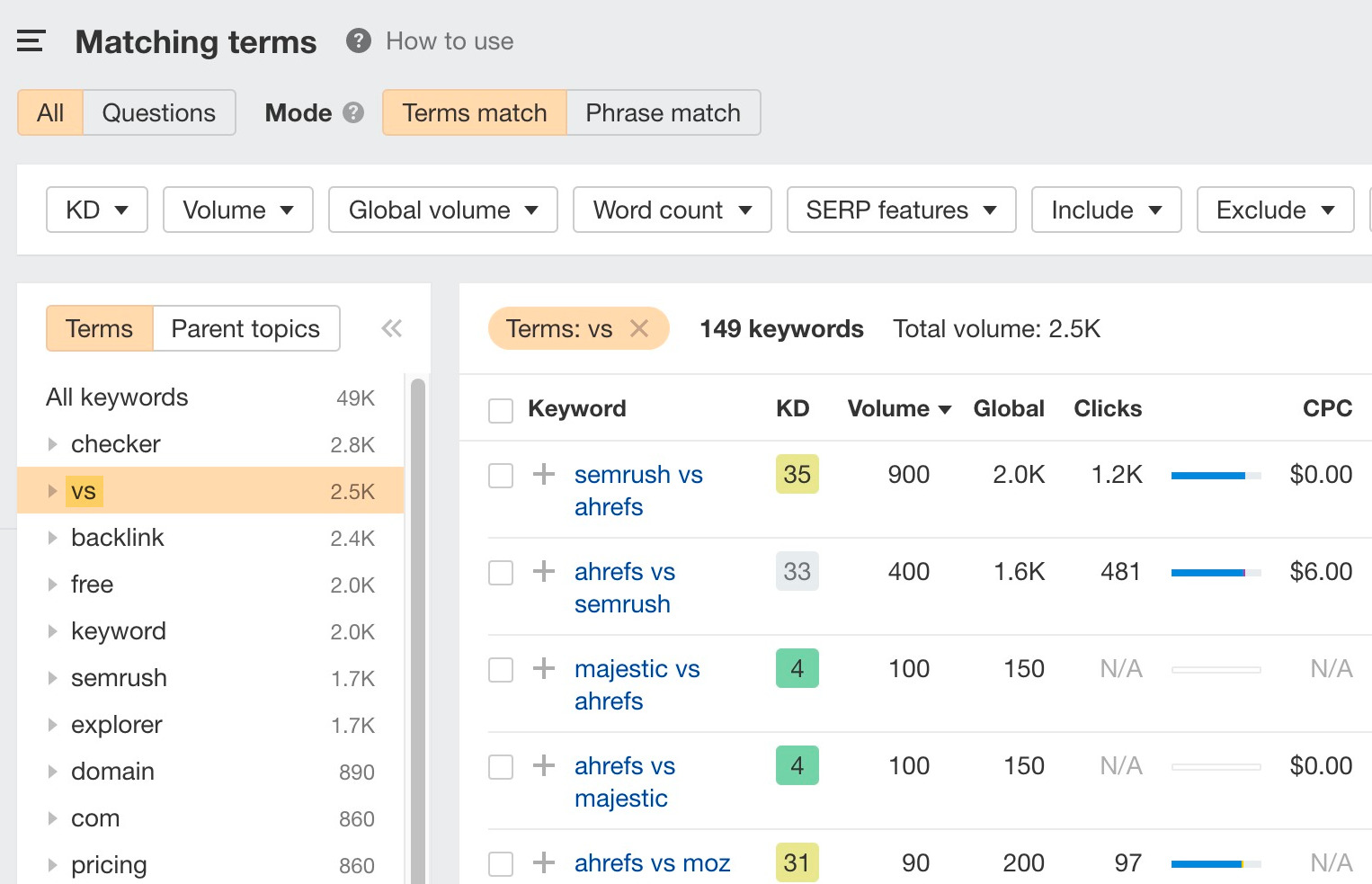
Doing this for our own brand shows that people are comparing us with Moz, SEMRush, and Majestic.
At this point, most businesses will create separate comparison pages for each competitor. However, we decided to do something different and created a versus page that tackled all of them at once.
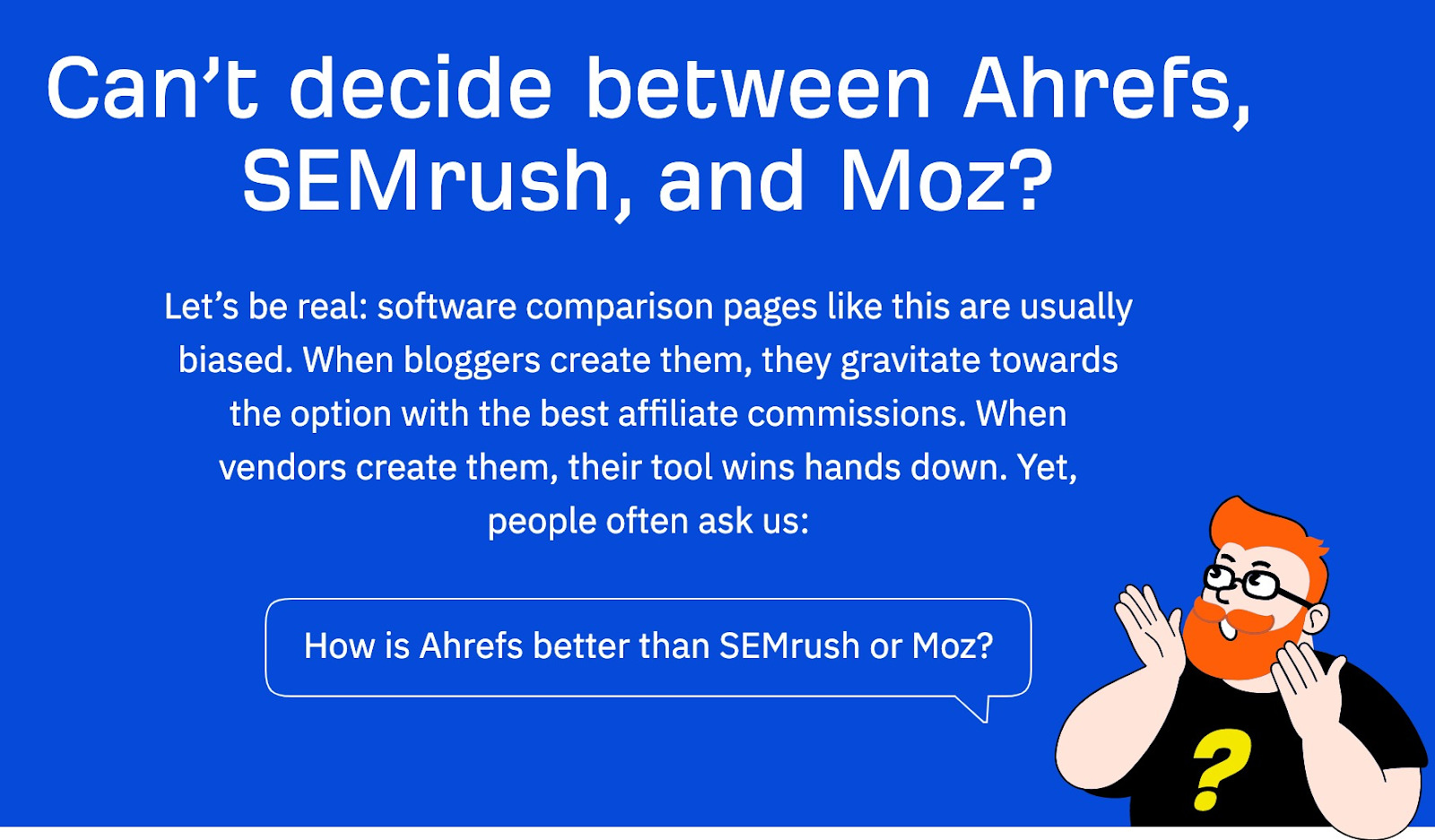
One page or a few—the choice is yours.
Journalists often need to back up their arguments with data. However, they don’t always have access to this information. So they’ll look for data online, then mention and link to that source of data.
For example, in 2020, Ahrefs was mentioned in Bloomberg because of our top Google searches data.
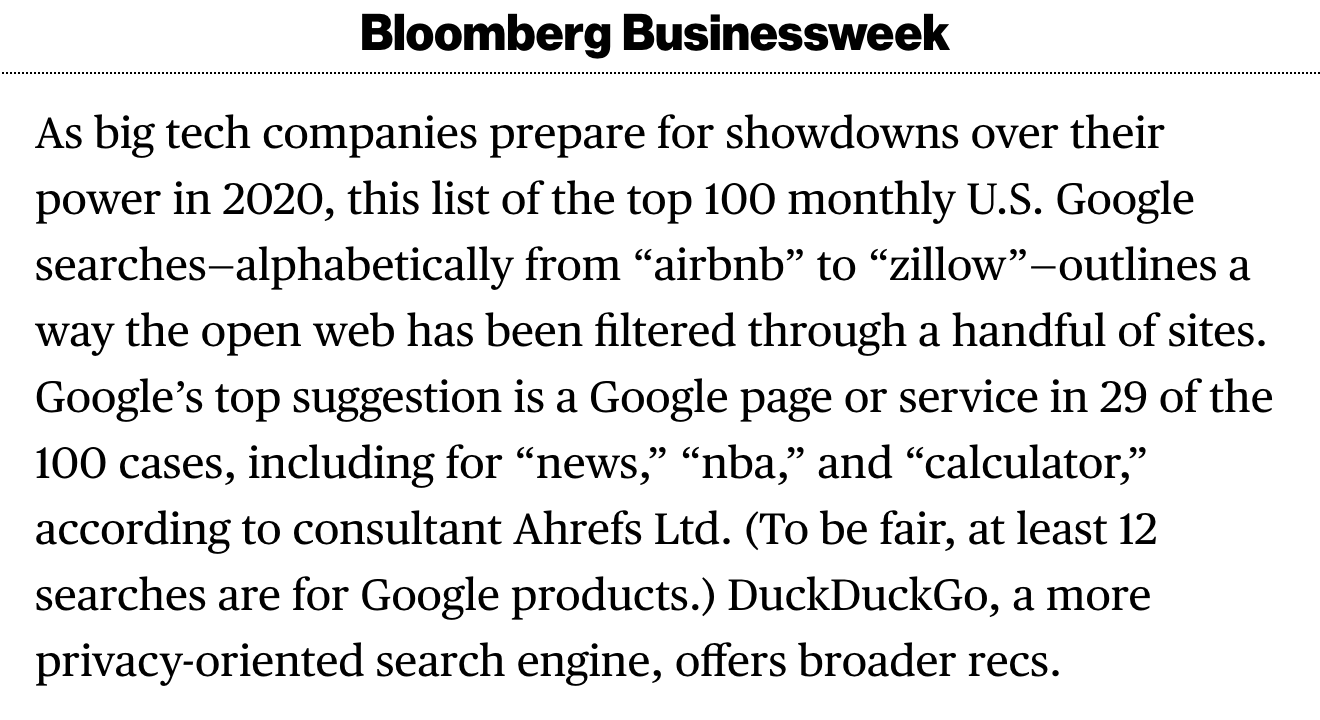
But not everyone has access to unique data. So one way to get around this is to curate a list of statistics for your industry.
That’s what we did when we created our SEO statistics page. Since then, we’ve ranked #1 for the query “SEO statistics” and have accumulated ~2.4K links from ~1.1K unique websites.
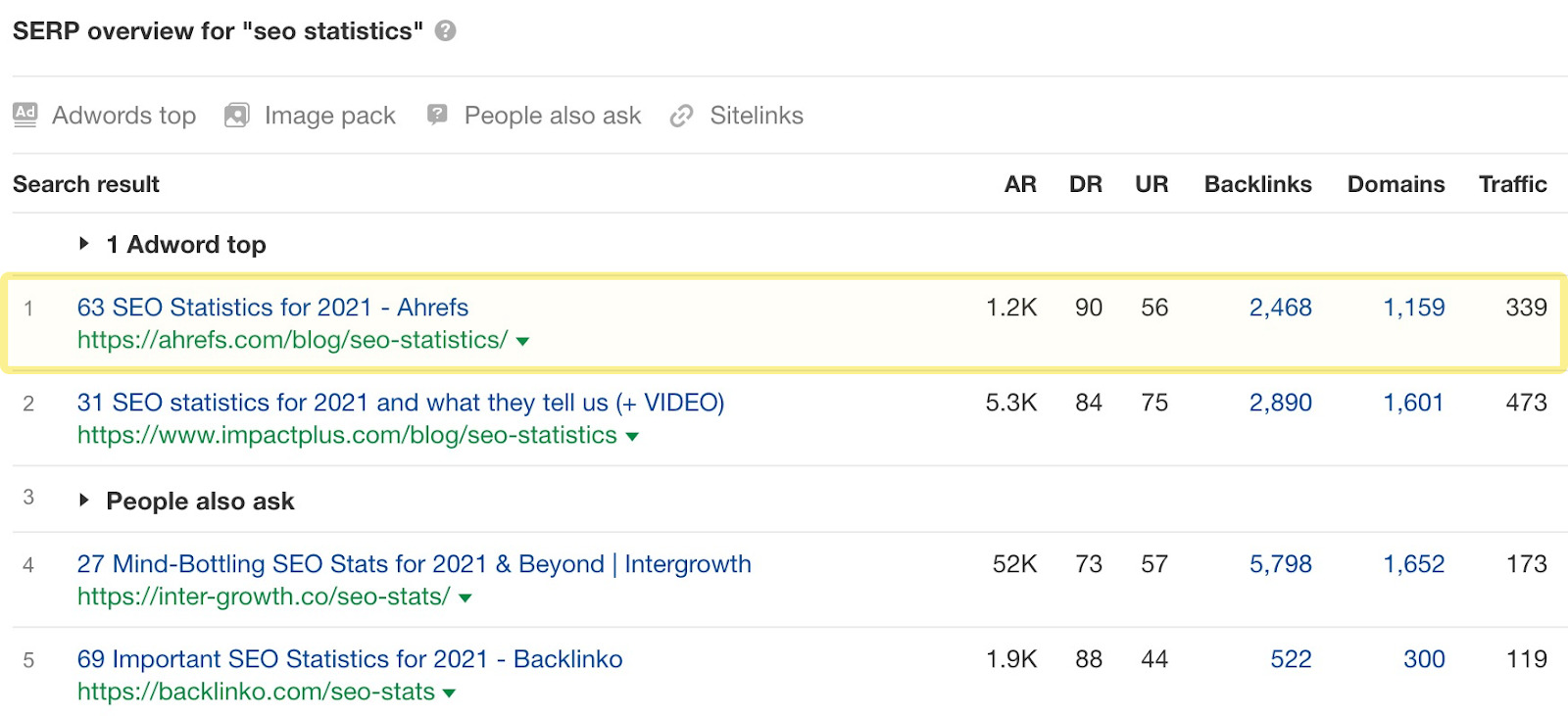
Learn how we did it here:
Recommended reading: Link Building Case Study: How We Built Backlinks With a ‘Stats’ Page
Not only do journalists need data, but they also need expert insights. And Help a Reporter Out (HARO) exists to connect journalists to experts.
If you’re an expert in your industry, you can be that source of information too. Sign up, monitor the requests in your category, and respond with valuable information as soon as possible.
My colleague, Michal Pecánek, has tons of experience with HARO. Here are some tips from him:
- Check the publication – Avoid those that aren’t authoritative.
- Be picky – Only respond to requests where you can truly provide great information.
- Respond as fast as possible – Many people are monitoring the same niche as you.
- Get help – Don’t hesitate to bring colleagues on board if they’re more qualified to answer.
- Stick to the script – Don’t deviate from the format the author is requesting.
Recommended reading: 9 Great Public Relations Tactics With Campaign Examples
If you’ve searched for something in Google and seen this…
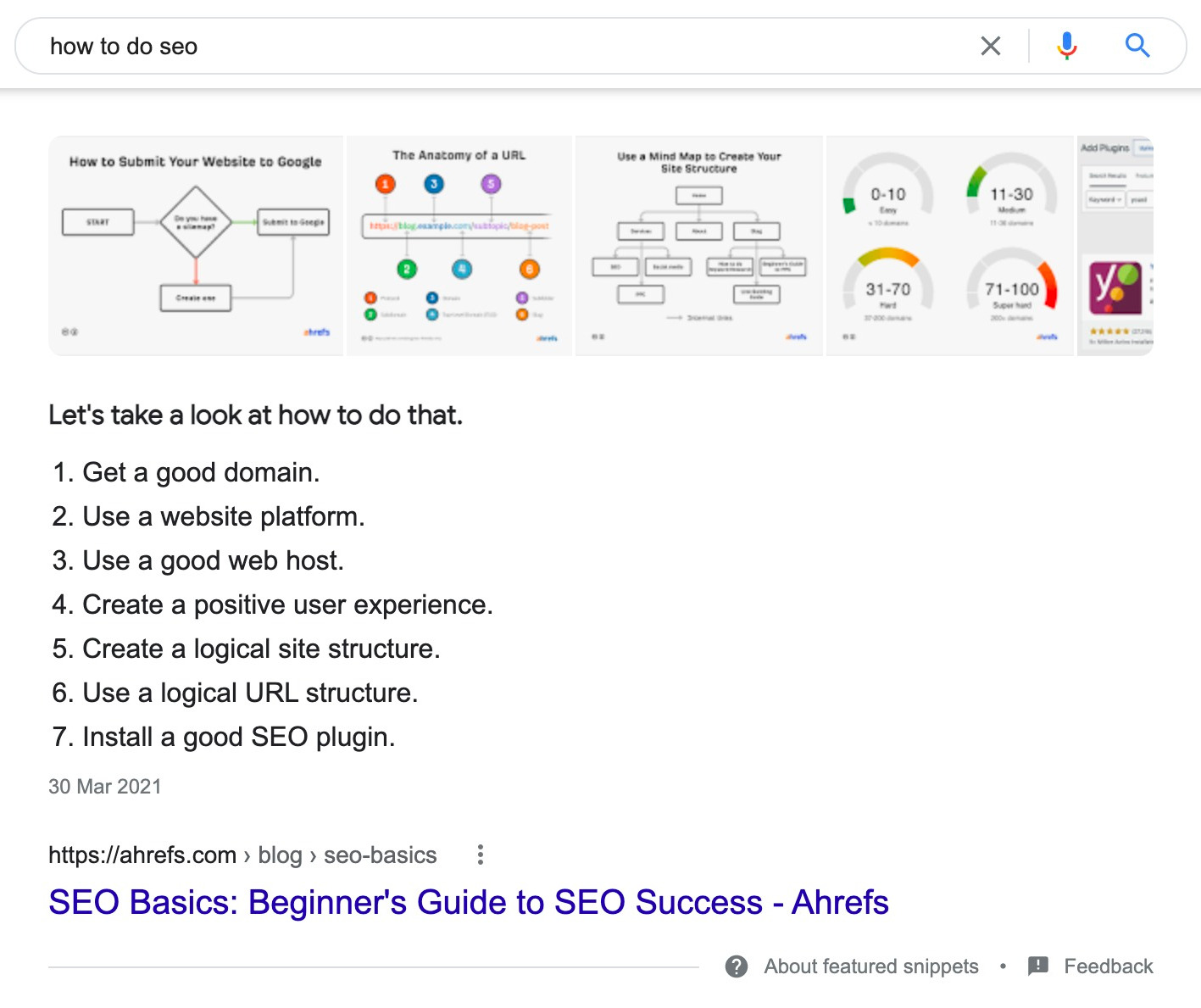
… then you’ve seen a featured snippet.
Capturing one means leapfrogging all the other ranking websites and jumping into the first position. And you can do this without having to build links or rewrite your content.
The easiest way to begin is to leverage content you already own. Here’s how to do it:
- Go to Ahrefs’ Site Explorer
- Enter your own domain
- Go to the Organic keywords report
- Filter for featured snippets (where target doesn’t rank for) using the SERP features filter
- Filter for positions #2-10 using the Position filter

You’ll get a list of low-hanging opportunities to steal featured snippets from your competitors.
Then, how do you capture these snippets?
We have a step-by-step guide that shows you how you can rework your content so that you stand the best chance of capturing the snippet. Read it below here.
Recommended reading: How to Optimize for Google’s Featured Snippets
YouTube videos rank on YouTube. Duh. But did you know YouTube videos rank on Google too?
In fact, our YouTube channel got over 200K views from Google in the past year:
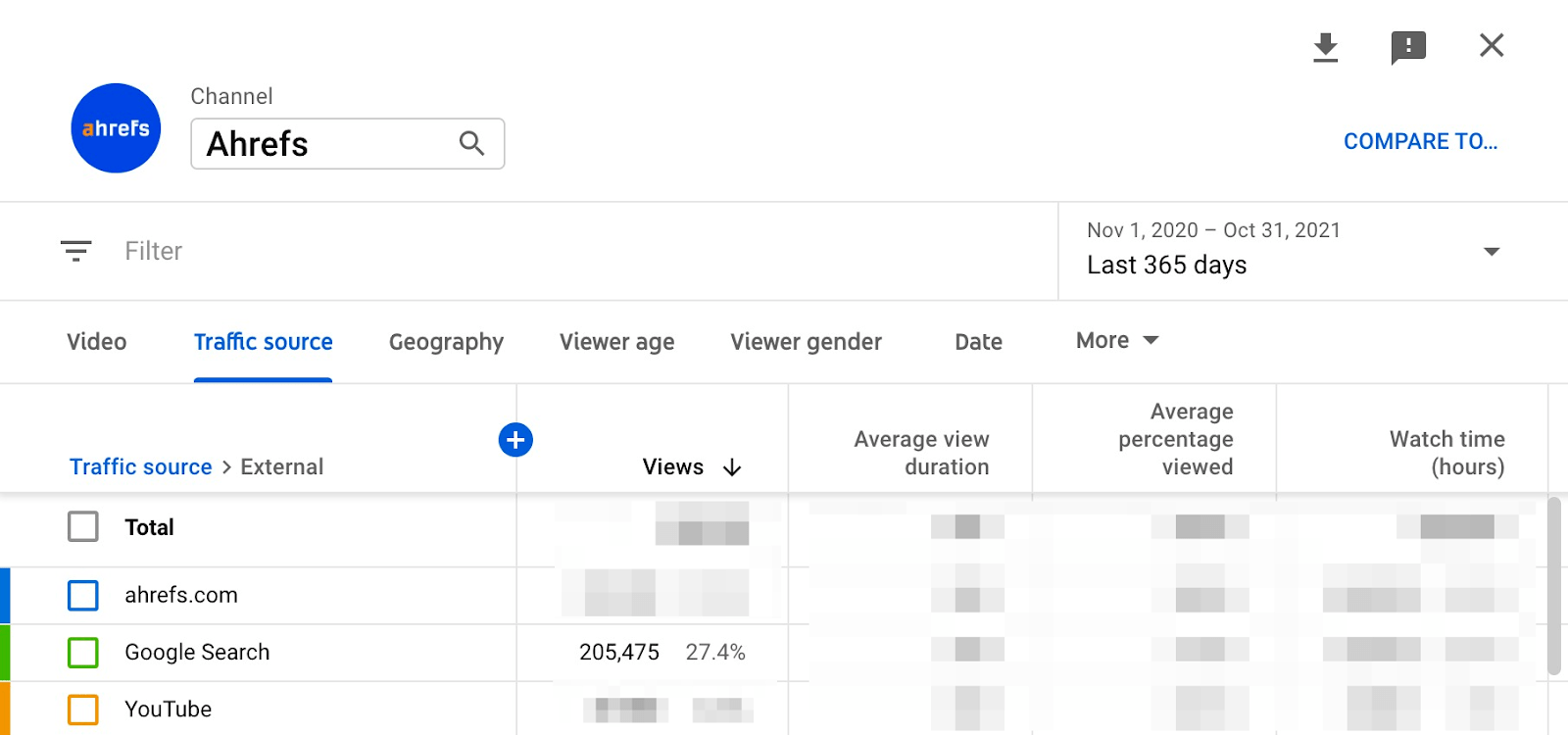
To do this, you’ll need to rank for topics that have both:
- Search traffic potential – People are searching for these topics on YouTube and Google.
- Video intent – People who prefer to watch a video instead of reading.
Here’s how to find these topics:
- Go to Ahrefs’ Content Explorer
- Run this search:
site:youtube.com inurl:watch title:topic - Sort the results by Page traffic

This should give you a list of relevant YouTube videos that currently get organic search traffic from Google. Eyeball the list for ones that are relevant to your business, then create a video that ranks:
Recommended reading: Video SEO: How to Rank YouTube Videos on Google
Everyone knows Facebook, Instagram, and Google Ads. Those are the go-tos when it comes to paid advertising. But don’t forget that YouTube, Twitter, Quora, and even TikTok have advertising platforms too. If your target audience is on these platforms and they fit your marketing objectives, then they’re worth considering.
For example, we regularly run ads on YouTube.
If you create YT tutorials that feature your product, consider spending 💰 on ads. Doesn’t have to be a lot. In July, we spent 154.62 SGD (~112.75 USD) for 174.8 hours of watch time (10,488 minutes).
— Sam Oh (@samsgoh) August 16, 2020
That’s $0.01/min or $0.65/hour. Name a cheaper medium for relevant/focused attn
We also run ads on Quora:
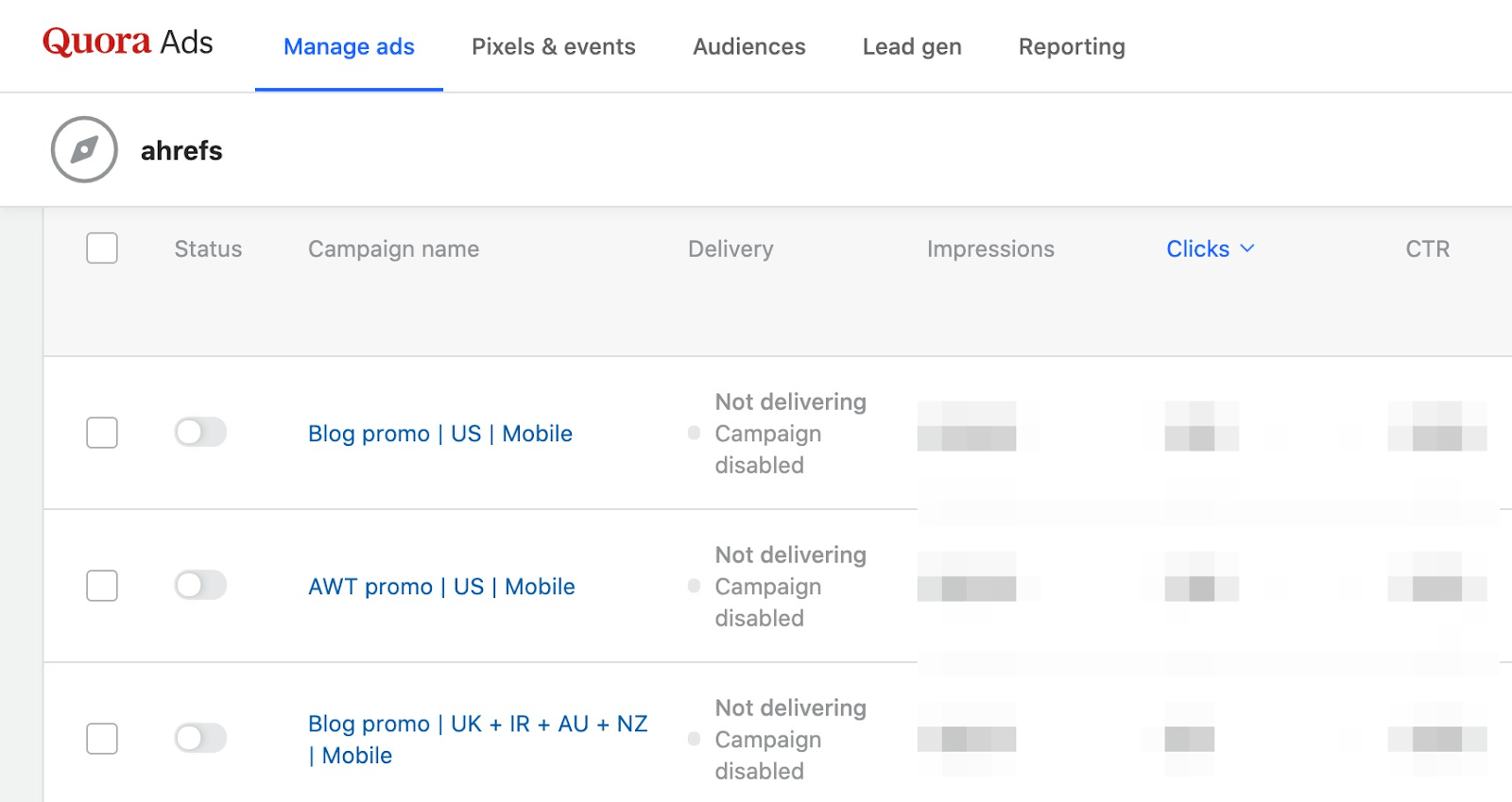
There’s a common saying that you should never do the same thing twice. If you find yourself doing something over and over again—and you’re not enjoying it at all—then it’s a task you can outsource.
Some tasks can be easily completed with the right tool. For example, instead of “copy-pasting” drafts to WordPress, we simply upload them by using Wordable.
For other tasks, you may have to hire freelancers or even a full-time staff. Create standard operating procedures (SOPs), hire and train people using those documents, and refine your system.
Learn how to outsource your marketing tasks using the framework below (it’s for SEO but can be generalized across any marketing channels):
Recommended reading: How to Outsource SEO (Simple Framework)
As you’re applying the tips from this post, keep a lookout for what’s working. Do the same for the existing channels and tactics you’ve been using.
Then, double down on them. Invest your resources. Make it generate more returns for you.
That’s what we did at Ahrefs. We started with the blog. And when it was working, we scaled it up by hiring more writers, creating SOPs, etc. And since we knew that content marketing was working for us, we invested in creating more content—this time on YouTube.
With an eight-figure annual recurring revenue (ARR), our results speak for themselves.
Pablo Picasso once said, “Good artists copy, great artists steal.”
Inspired by this quote, marketers started copying each other. If there was a strategy that worked, countless others would follow suit—sometimes without consideration for their own circumstances.
Sometimes, this idea worked. But most of the time, what happened was that the marketplace was glutted with imitations.
I guess there’s a new trend in SaaS homepage design 😆 pic.twitter.com/5qhQOCVBi5
— Tim Soulo 🇺🇦 (@timsoulo) July 12, 2019
Marketing is about differentiation. That’s why you need a positioning strategy. That’s why you create a comparison page. You want to stand above the competition. But if you are the same as the rest, there’s no reason for others to choose you.
I think there’s nothing wrong with following best practices. But try to add your own twist. For example, look at our homepage and our versus page.
The tactics we used are not unique, but we’ve always tried to be different.
Final thoughts
I hope you’ve walked away from this post with a handful of actionable digital marketing tips you can test for your business.
Did I miss out on any cool tips? If you have any to share, let me know on Twitter.




